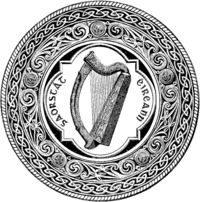Great Seal of the Irish Free State

The Great Seal of the Irish Free State (Irish: Séala Mor do Shaorstát Éireann) is the seal which was used to seal official documents of the Irish Free State (Saorstát Éireann) by the Governor-General. The Great Seal is currently on public display at National Museum of Ireland at Collins Barracks, Dublin.
Both sides of the Great Seal feature an image of the harp surrounded by the words "SAORSTÁT ÉIREANN" in Gaelic script. One side is engraved in silver, the other in copper.
After the 1937 Constitution of Ireland was enacted the Seal of the President of Ireland was struck as a replacement to the Great Seal. It is substantially the same as the former Seal but features the word "ÉIRE" instead of "SAORSTÁT ÉIREANN".
Origins
As early as August 1922 civil servants in the Provisional Government sought Ministerial approval to adopt a seal. It was thought a seal was necessary for legal reasons.[1] An approach was made by Hugh Kennedy, the Attorney General to Thomas Sadleir, Registrar of the Office of Arms at Dublin Castle. In his reply Sadlier noted that he was “satisfied that the harp was very early in the 12th century an Irish badge...” In December 1922, George Sigerson, the President of the National Literary Society, recommended to Tim Healy, the Governor-General of the Irish Free State that the harp should be adopted as the symbol of the Free State. His view was that:[1]
The harp was the common and sacred symbol of the Protestant Volunteer of 1782, of the Presbyterian and Catholic United Irishmen of 1798, of old and young Ireland and of men of after days – it is in no sense a party or sectional symbol but one which represents the entire Nation...It is now within the power of an Irish Independent Government to place this emblem of humanizing harmony in its high place of honour, unique and not undistinguished amongst the lions, the leopards, and the single and double headed Eagles of the rest of the world.
On 28 December 1922 a meeting of the Executive Council of the Irish Free State decided that the Celtic Harp should be adopted.[1] Later, in August 1923 the Executive Council determined that the “Brian Ború Harp” would be the basis of the new seal. Archibald McGoogan of the Art Department of the National Museum perfected the design.[1] Elements of the Ardagh Chalice were incorporated into the design of the Great Seal. Final authorisation was given by the Executive Council on 17 October 1924 for the provision of the various seals. These included Ministerial Seals, using the ‘Brian Ború’ Harp and with “Saorstát Éireann” and the Ministerial title arranged around the harp in both Irish and English. The rope pattern was a direct copy of the base of the Ardagh Chalice.[1]
Evolution
In March 1931, important changes in constitutional procedure in the Irish Free State were announced. The reforms meant that in future the King would be advised directly in matters concerning the Irish Free State's foreign affairs instead of through the Secretary of State for the Dominions.
Announcing the changes, the Irish Free State stated that the sealing of international documents with the Great Seal of the Realm had caused confusion in the minds of foreign Governments and that the decision would bring constitutional forms into conformity with the constitutional position now existing.[2]